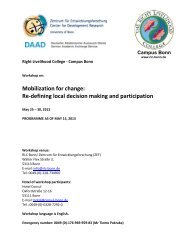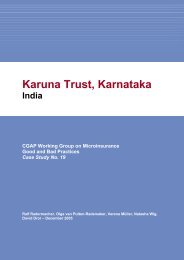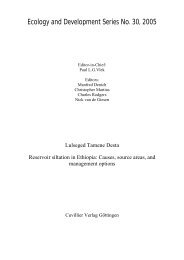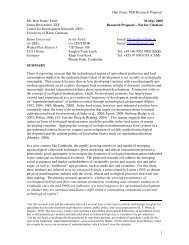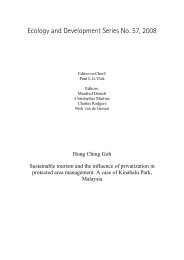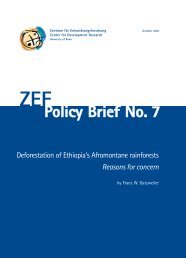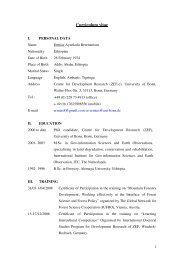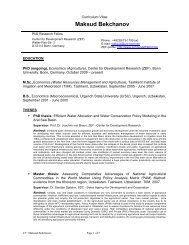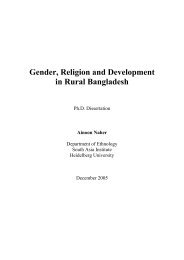ZEF Bonn
ZEF Bonn
ZEF Bonn
Create successful ePaper yourself
Turn your PDF publications into a flip-book with our unique Google optimized e-Paper software.
lowered by as much as 5°C. As a consequence, the partial pressure of NH3, which is<br />
an indicator of potential N volatilisation, was significantly depressed. The total N<br />
uptake increased by as much as 42 % and the total dry matter yield by as much as<br />
36 % on Azolla-covered plots. The grain yield was likewise improved. Grain yields<br />
from the 16 on-farm trials increased by as much as 40% at lower N rates (40 and<br />
50 kg N ha-1) and still by 19 % at higher N rates (80 and 100 kg N ha-1).<br />
Thus, using Azolla as a surface cover in combination with urea can be an alternative<br />
management practice to reduce N losses and improve N-use efficiency, and is worth<br />
considering.<br />
3.2.3 Management of soil ecology<br />
Within the bilateral German-Brazilian SHIFT Project on the “Management of plant<br />
organic matter and its effects on litter decomposition and soil macrofauna in central<br />
Amazonian agroecosystems", <strong>ZEF</strong> is studying the effects of the management of<br />
plant debris in agricultural systems on soil fauna and nutrient cycling. As one of the<br />
most important soil fauna groups, termites play a central role in these systems. The<br />
study consists of field experiments, experiments in microcosms, a screening of different<br />
decomposition systems and experiments on ecotoxicology. The field experiments<br />
comprise three experiments on the manipulation of litter quantity and quality<br />
and an experiment on mulching with wood residues.<br />
3.3 Ecosystems in a Development Context<br />
Uncontrolled exploitation of natural resources has led and will continue to lead to<br />
the irreversible loss of valuable and unique natural resources. There is general international<br />
consensus on using natural resources wisely and in a sustainable manner.<br />
However, poverty and market mechanisms still favour unsustainable resource exploitation.<br />
It is rather difficult to calculate economic values for natural resources, especially<br />
for “service functions" and biodiversity. There is an urgent need to design<br />
appropriate policies and to explore incentive mechanisms that would favour sustainable<br />
use of resources.<br />
<strong>ZEF</strong> pursues projects that provide a better insight into the principles of ecosystem<br />
functioning. Some of these projects are already mentioned in the previous chapter<br />
on sustainable land use systems (Uzbekistan and Uganda Project), as these two research<br />
themes do overlap to a large extent by their very nature. The bilateral German-<br />
Brazilian SHIFT project “Secondary Forests and Fallow Vegetation in the Agricultural<br />
Landscape of the Eastern Amazon Region, Brazil" as well as the associated SHIFT<br />
project “Smallholders in the Amazon: Interaction between Ecosystem and Social<br />
Systems in the Utilization and Protection of Tropical Rainforests" deal with human<br />
impact on ecosystems and are focusing on concepts for using natural resources in a<br />
sustainable manner. Details are given in a previous section of this report.<br />
Research<br />
Uncontrolled exploitation of<br />
natural resources has led to<br />
the irreversible loss of valuable<br />
and unique natural resources.<br />
There is an urgent need to<br />
design appropriate policies and<br />
to explore incentive mechanisms<br />
that would favour<br />
sustainable use of resources.<br />
59



